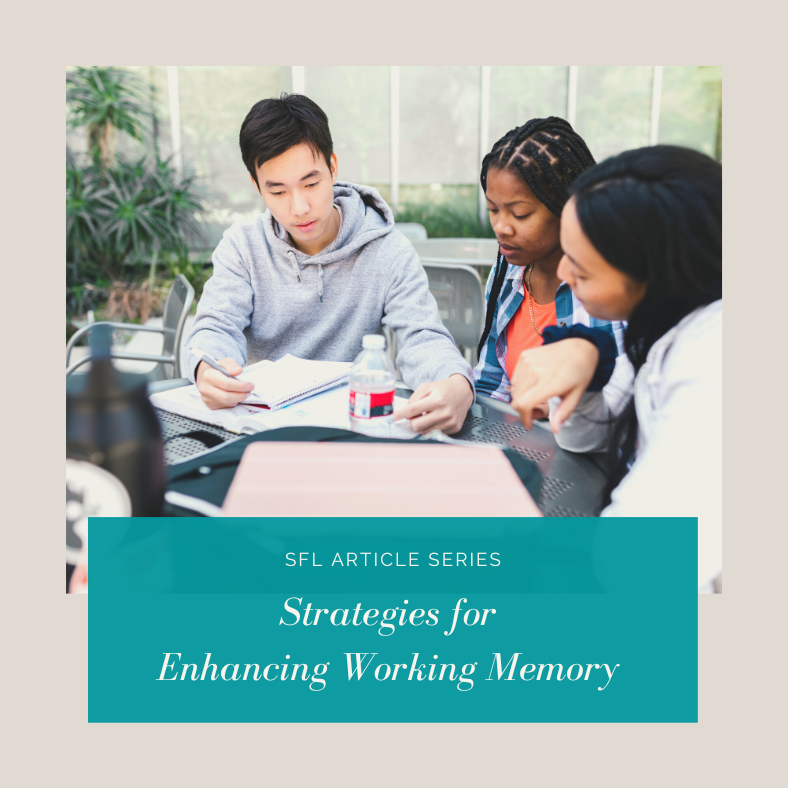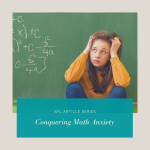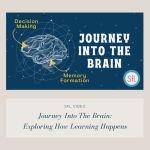No products in the cart.

Written by Susan Ardila, M.Ed Math Education K-12
In the realm of educational therapy, empowering students with learning differences is at the forefront of our mission. One critical aspect of cognitive development that significantly impacts learning is working memory. Memory is an essential cognitive function that plays a crucial role in learning and academic success. For students with learning differences, such as attention deficit disorder (ADD) or dyslexia, impairments in short-term memory can pose significant challenges in the classroom. However, there are effective strategies that parents and teachers can employ to enhance short-term memory and support these students’ educational journey. In this thought-provoking blog post, we will explore the best practices to boost working memory in students, and we’ll provide explicit examples of how they can be implemented effectively at home and in the classroom By implementing these strategies, parents and teachers can create a supportive learning environment that fosters academic growth and success.
Understanding Working Memory:
Before we dive into strategies, let’s briefly understand what working memory is. Working memory, often referred to as our mental workspace, is the cognitive system responsible for temporarily holding and manipulating information needed for various cognitive tasks, such as problem-solving and comprehension. It’s a fundamental component of learning and academic success. It allows students to follow instructions, keep track of multiple pieces of information simultaneously, and make connections between different concepts. When working memory is impaired, it can lead to difficulties with attention, organization, problem-solving skills, and overall academic performance.
Strategy 1: Chunking Information
One effective technique to enhance working memory is chunking information into smaller, more manageable units. Instead of bombarding students with long lists of information or complex instructions all at once, break them down into smaller chunks. For example, when teaching a new concept or giving instructions for an assignment, present the information in bite-sized portions followed by opportunities for repetition and reinforcement. This approach enables students to process and retain the information more effectively.
Example for Parents:
Imagine your child has a list of 10 spelling words to memorize. Instead of presenting all the words at once, break them into smaller groups. Start with three words, have your child practice and recall them, and then add the next three. Continue this process until they can confidently recall all 10 words. This chunking technique makes it easier for working memory to process and retain information.
Example for Educators:
In the classroom, when introducing a complex mathematical equation, break it down into smaller, manageable parts. Teach and practice each part separately before combining them into the complete equation. This approach reduces the cognitive load on students with learning differences, allowing them to grasp and remember the concept more effectively.
Strategy 2: Visualization
Visual aids are powerful tools that engage both visual and spatial processing systems in the brain while supporting working memory. Utilize graphic organizers such as mind maps, flowcharts, or diagrams to visually represent information hierarchies or relationships between different concepts. These visual cues provide students with a clear and organized framework to understand and remember complex information.
Example for Parents:
If your child is learning historical facts or dates, encourage them to create mental images associated with each fact. For instance, if they’re learning about a famous historical figure, ask them to visualize that person in a historical setting. These mental images can serve as memory cues.
Example for Educators:
In the classroom, when teaching a new vocabulary word, provide students with a visual aid or illustration that represents the word’s meaning. Associating a visual image with the word enhances students’ ability to remember and recall it, especially those with learning differences who may benefit from multi-sensory learning.
Strategy 3: Repetition and Spaced Practice
Repetition is key when it comes to strengthening memory pathways. Encourage students to review previously learned information regularly, reinforcing the neural connections in their brains. Additionally, spaced learning techniques involve distributing study sessions over time rather than cramming all at once. This method optimizes memory consolidation by allowing for periods of rest and retrieval practice between study sessions.
Example for Parents:
When helping your child study for a test, encourage them to review the material multiple times over a few days, rather than cramming it all in one session. Repetition and spaced practice strengthen memory retention.
Example for Educators:
In the classroom, incorporate regular review sessions into the curriculum. For instance, if you’ve covered a particular topic in science, revisit it briefly in subsequent lessons to reinforce students’ memory of the material.
Strategy 4: Active Engagement and Mnemonic Devices
Active engagement during learning has been shown to significantly improve memory retention. Encourage students to actively participate in class discussions, ask questions, and make connections between new information and prior knowledge. Furthermore, mnemonic devices like acronyms, visualization techniques, or memorable associations can aid in recalling information more easily. These creative strategies stimulate the brain’s capacity for encoding and retrieval.
Example for Parents:
Teach your child mnemonic techniques like acronyms or rhymes to remember lists or sequences. For example, to remember the order of operations in math (PEMDAS: Parentheses, Exponents, Multiplication, Division, Addition, Subtraction), create a memorable phrase like “Please Excuse My Dear Aunt Sally.”
Example for Educators:
In the classroom, mnemonic devices help students remember complex information. For instance, when teaching the names of planets, use a mnemonic like “My Very Educated Mother Just Served Us Noodles” to represent Mercury, Venus, Earth, Mars, Jupiter, Saturn, Uranus, and Neptune.
Strategy 5: Multisensory Learning
Engaging multiple senses simultaneously can significantly enhance memory retention. Encourage students to learn through multisensory experiences by incorporating auditory, visual, and kinesthetic elements into their study routines. For instance, while studying vocabulary words, students can say the word out loud (auditory), visualize its meaning or use in a sentence (visual), and write it down or act it out (kinesthetic). This multisensory approach strengthens neural connections and reinforces memory recall
Example for Parents:
Incorporate tactile and kinesthetic activities into learning. If your child is studying geography, use a map puzzle where they physically place pieces in the correct locations. This hands-on approach engages different senses and enhances memory.
Example for Educators:
Utilize multisensory techniques in the classroom, especially for students with learning differences. When teaching spelling, have students trace the letters with their fingers while saying the word aloud. This combination of visual, tactile, and auditory input aids memory retention.
Enhancing short-term memory is a crucial aspect of supporting students with learning differences on their educational journeys. By implementing these strategies—chunking information, visualization, repetition and spaced practice, mnemonics, and multisensory learning—parents and educators can create an optimal learning environment and provide valuable support for students in both home and classroom settings that nurture working memory development.
As educational therapists, our goal is to unlock the potential of every student. By empowering them with effective strategies to enhance working memory, we pave the way for improved academic performance and increased confidence. Together, we can create a learning environment where every student can thrive, regardless of their learning differences.
Learn more math related challenges and how SfL can help support students to become more confident and independent learners.
Additional Resources:






